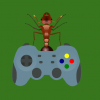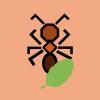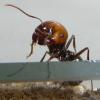Breeding a fungus that festers within the alates of ants needs some mode of spreading, and if it outright kills off alates, then the spread has to be through other animals such as birds or other insects - think of horsehair worms for example. It also doesn't seem like a good idea to introduce alien diseases and funguses into habitats, just sounds like that would be asking for issues.
S. invicta (S. saevissima-group) and native S. geminata-group species are unlikely to hybridize due to being different species groups; it also would've happened already if it would happen due to S. invicta overlapping S. geminata-group species in the US for decades. If it did hybridize, we then would just have hybrids of a native and exotic species, which doesn't sounds any better than having an exotic. The hybrid might be able to fend off against the exotic better, but would likely have the downside of being dominant over the non-hybrid natives.
The workerless inquiline, S. daguerrei, would do very little to kill off S. invicta considering it doesn't "convert colonies" into being conspecific and has the chance of being a new pest - there isn't an amazing track record with introducing new exotics to keep other exotics in check. We would also have to hope that the environment through all of the range S. invicta is in can also support the inquiline species. In a fantasy world, there would be a non-Formicidae species that is an S. invicta specialist that parasitizes the larvae like some wasps do to Pheidole. The issue, however, is the mode of spread for those wasps, is they lay their eggs in flowers, which the ants pickup when drinking from said flowers. The eggs then need to be carried on the ant all the way back to the nest and then transferred directly to the larvae.
A species-specific pesticide with no harm done to the habitat is something out of fantasy as it's basically impossible to test the short-term and long-term effects of it on everything from across all of the South US and California. It has also been in the works for decades with no sign of anything coming to fruition anytime soon. If we did make a species-specific pesticide, we would have to use it religiously, which leads to the issue of what's dubbed the Pesticide Treadmill. The Pesticide Treadmill is where the target species adapts to the pesticide after prolonged use and then a new, stronger, more destructive pesticide has to be formulated.
Even without the ability to sting, S. invicta grow at a very rapid rate and is better suited to the environments they are invasive in. They can overwhelm numerous native species with ease. Look at non-stinging invasives such as Linepithema humile, Pheidole navigans, and Brachymyrmex patagonicus, none can sting and yet they are very prominent.
The true way to eradicate S. invicta is to revert all land back to how it was before humans stepped foot through it and heavily altered it. Even then, some small populations of invasives will still stay, which is just the consequence of human transportation. But, like what AntDrew and others have said, there's no stop to it. There are more dangerous invasives that are more recently introduced such as Wasmannia auropunctata. Solenopsis invicta has been long established, so it would be wise to try to erradicate potential threats instead of going after one that has been long-established and settled into its range.


















